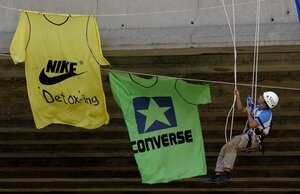 ?
?
Greenpeace activists executing a protest today at the Marikina River in Metro Manila ? Alanah Torralba / Greenpeace - more photos below
Marikina City/Beijing, 23 August 2011
The latest research into toxic water pollution released today by Greenpeace International reveals the presence of nonylphenol ethoxylates [1] in clothing items bearing the logos of 14 global brands [2], including Adidas, H&M, and Abercrombie and Fitch.
The chemicals, which break down to form nonylphenol - which has toxic, persistent and hormone-disrupting? properties - were detected in clothes bought and manufactured in locations all over the world, demonstrating that the use and release of hazardous chemicals is a widespread and pervasive problem with serious, long-term and far-reaching consequences for people and wildlife.
Have You Been Affected? Click Here
"Our research shows that global clothing brands are responsible for the discharge of hazardous chemicals into waterways in China and across the world, as part of their manufacturing processes," said Beau Baconguis, Toxics Campaigner of Greenpeace Southeast Asia. "People have a right to know about the chemicals that are present in the very fabric of their clothing and the harmful effects these chemicals have when released into the environment."
Launched today at the Marikina River, Greenpeace's second "Dirty Laundry" report [3] presents the results of analysis of clothing and fabric-based shoes sold internationally by major clothing brands. Of the 78 articles tested, 52 were found to contain nonylphenol ethoxylate (NPE), a chemical which breaks down into the hormone-disrupting nonylphenol. The highest level found among the products tested was a Converse t-shirt manufactured in the Philippines.? The findings provide a snapshot of the kind of toxic chemicals that are being released by the textile industry into waterways all over the world and are indicative of a much wider problem.
Discharge of most hazardous chemicals is not regulated under Philippine laws.? The Amended Priority Chemicals List - the list of hazardous chemicals that must be prioritized for action, issued by the Department of Environment and Natural Resources (DENR) in 2005 - does not even include NPEs.? Workers involved in the manufacture of sports apparel and the communities that host the facilities are probably being exposed to NPEs without their knowledge.
A Greenpeace activist watched by a street sweeper fixes a "clothesline" with huge mock shirts representing 14 big, global brand names found to have harmful levels of toxic chemicals, as revealed in the Greenpeace toxic water report, "Dirty Laundry 2: Hung out to Dry", which was launched today at the Marikina River in eastern Metro Manila, Philippines. 23 August 2011. Nike, along with Puma, already made commitments to eliminate toxic chemicals in their respective products and production lines by 2020. Converse, which had products manufactured in the Philippines having the highest number of toxics, and other brands, including Adidas, are being asked to follow Puma and Nike's lead. ? Alanah Torralba / Greenpeace?
The first Greenpeace Dirty "Laundry" report, released six weeks ago, detailed the results of a year-long study linking many of the same clothing brands [4] to suppliers in China who were found to be releasing a cocktail of chemicals into the Pearl and Yangtze River deltas [5]. As a result of the global "Detox" campaign, which has included a global striptease [6] and "re-branding activities" [7] at the companies' stores, both Nike and Puma have publicly committed [8] to the elimination of all discharges of hazardous chemicals from their supply chains and products.
"Now that Nike and Puma have committed to cleaning up their supply chains, and are using their power as brand owners to influence the environmental impacts of production, Adidas and other leading clothing brands can no longer avoid the responsibility of ensuring that the environment, their customers and people across the world are no longer threatened by the release of hazardous chemicals", said Baconguis.
"By failing to take action to eliminate these chemicals, global brands like Adidas are expecting customers to do their dirty laundry for them; every time clothes containing these chemicals are washed, hazardous substances are released into rivers across the world. Brands must remove these chemicals from their products, and the best way to do this is to eliminate them from the production process", Baconguis concluded.
Greenpeace is an independent global campaigning organisation that acts to change attitudes and behaviour, to protect and conserve the environment and to promote peace. Greenpeace is campaigning to stop industrial pollution of our water with hazardous, persistent and hormone-disrupting chemicals by demanding that companies and governments take action to "Detox" our future.
DETAILS
[1] Greenpeace International submitted 78 articles of clothing for analysis by a leading independent laboratory, which examined them for the presence of nonylphenol ethoxylates (NPEs). Where released untreated, NPEs break down in rivers to form the persistent, toxic and hormone disrupting NonylPhenol (NP). Even where wastewater treatment facilities are present, they are unable to fully breakdown NPEs, and instead only partially degrade them - often even speeding up their conversion into the toxic NP. More detailed information on this substance at page 12 of "Dirty Laundry II" at http://www.greenpeace.org/dirtylaundry2.pdf and on page 51, Box 2.2, of the "Dirty Laundry" report, available at www.greenpeace.org/dirtylaundry
[2] The 14 brands where traces of NPEs were detected above the detection limit were Abercombie & Fitch, Adidas, Calvin Klein2, Converse, G-Star RAW, H&M, Kappa, Lacoste, Li Ning, Nike, Puma, Ralph Lauren, Uniqlo and Youngor.
[3] "Dirty Laundry II: Hung out to Dry" is available at: http://www.greenpeace.org/dirtylaundry2.pdf
[4] Brands found to have links with suppliers in China who were found to be discharging hazardous chemicals included: Abercrombie & Fitch, Adidas, Bauer Hockey, Calvin Klein, Converse, Cortefiel, H&M, Lacoste, Li Ning, Meters/bonwe, Nike, Phillips-Van Heusen Corporation (PVH Corp), Puma and Youngor.
[5] For more information please refer to the ?Dirty Laundry' report at: www.greenpeace.org/dirtylaundry
[6] http://www.greenpeace.org/international/en/news/Blogs/makingwaves/hundreds-strip-to-challenge-nike-and-adidas-t/blog/35853/
[7] www.greenpeace.org/international/en/news/Blogs/makingwaves/rebranding-adidas-to-detox-our-water/blog/36412/
[8] Puma's commitment available here: http://safe.puma.com/us/en/2011/07/puma-is-committed-to-eliminate-discharges-of-hazardous-chemicals-2/ Nike's commitment available here: http://www.nikebiz.com/media/pr/2011/08/17_zero_discharge.html
Want To Contribute Stories/Features? Click Here
13
Posted at: 01:11 | Add Comment  |
|  |
|  del.icio.us
del.icio.us